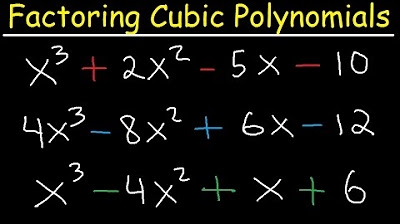Lec 33 - Algebra of polynomials: Multiplication
Summary
TLDRThis video tutorial teaches the method of multiplying polynomials of arbitrary degrees. It starts with the basics, explaining the multiplication of monomials and binomials using the FOIL method, then generalizes the process for polynomials. The instructor demonstrates multiplying a trinomial by a monomial, extending the concept to include quadratic expressions, and provides a formula for finding the coefficient of any term x^k in the product. The video concludes with an example of multiplying two quadratic polynomials, illustrating the systematic approach to polynomial multiplication.
Takeaways
- 📚 The video is a tutorial on how to multiply polynomials of arbitrary degrees, starting with the basics of binomial multiplication using the FOIL method.
- 🔢 It explains the multiplication of monomials and how to apply the law of exponents when multiplying terms with the same base.
- 📈 The script demonstrates the process of multiplying a quadratic polynomial by a cubic monomial, showing the application of the law of exponents and simplification of the result.
- 📝 The concept of extending the FOIL method for binomials to polynomials with more than two terms is introduced, emphasizing that FOIL only applies to binomials.
- 📚 The tutorial provides a step-by-step method for multiplying polynomials by converting them into monomials and multiplying each term individually.
- 🔑 A general formula is presented for finding the coefficient of a term \( x^k \) in the product of two polynomials, which involves summing the products of coefficients where the indices sum to \( k \).
- 📉 The script illustrates how to apply this formula to polynomials of arbitrary degree, showing that the degree of the resulting polynomial is the sum of the degrees of the original polynomials.
- 📝 The importance of recognizing that not all coefficients are listed and that missing coefficients are assumed to be zero is highlighted.
- 📑 An example is worked through to demonstrate the application of the formula, showing the computation of the coefficients for each power of \( x \) in the product of two quadratic polynomials.
- 🔍 The video concludes with a note on the difference between polynomial multiplication, which always results in a polynomial, and division, which may not.
- 👋 The script ends with a sign-off, indicating that the next video will cover polynomial division and its potential outcomes.
Q & A
What is the FOIL method mentioned in the video script?
-The FOIL method is a technique used to multiply two binomials. It stands for First, Outer, Inner, Last, which refers to the process of multiplying each term of the first binomial by each term of the second binomial.
How does the video script generalize the multiplication of polynomials beyond binomials?
-The script generalizes polynomial multiplication by considering monomials and extending the concept to polynomials of arbitrary degree. It involves multiplying each term of one polynomial by each term of the other polynomial and applying the law of exponents.
What is the standard rule of multiplication for monomials as described in the video?
-The standard rule for multiplying monomials involves multiplying the coefficients and adding the exponents of like bases. For example, multiplying 2x^3 by x^2 results in 2x^(3+2) = 2x^5.
How does the video script handle the multiplication of a trinomial and a monomial?
-The script suggests converting the trinomial into separate monomials and then multiplying each of these monomials by the monomial of the other polynomial. This is an extension of the method used for monomials.
What is the difference between the FOIL method and the method described for multiplying a quadratic and a linear polynomial?
-The FOIL method is specific to binomials, while the method described in the script for multiplying a quadratic and a linear polynomial involves treating each term of the quadratic as a separate monomial and multiplying it by the linear polynomial, which is also treated as a monomial.
How does the script suggest finding the coefficient of a specific term in the product of two polynomials?
-The script provides a general formula where the coefficient of x^k is the sum of products of coefficients from each polynomial, where the sum of the indices of the coefficients equals k.
What is the significance of the formula ∑(j=0 to k) a_j b_(k-j) in the context of the video script?
-This formula is used to find the coefficient of x^k in the product of two polynomials. It represents the sum of all possible products of coefficients from the two polynomials where the sum of the indices equals k.
How does the script approach the multiplication of two polynomials of arbitrary degrees?
-The script suggests using the general formula to find the coefficients of each term in the product polynomial. It involves summing over all possible combinations of coefficients from the two polynomials that result in the desired exponent.
What is the degree of the resulting polynomial when multiplying two polynomials of degrees m and n?
-The degree of the resulting polynomial is m + n, assuming m is not equal to n. If m is equal to n, the degree is 2n.
Can the multiplication of two polynomials always result in a polynomial, according to the video script?
-Yes, the multiplication of two polynomials will always result in another polynomial. However, the division of two polynomials may not always result in a polynomial, as mentioned towards the end of the script.
What is the next topic the video script suggests covering after polynomial multiplication?
-The next topic suggested by the script is the division of two polynomials, which may not always result in a polynomial.
Outlines

This section is available to paid users only. Please upgrade to access this part.
Upgrade NowMindmap

This section is available to paid users only. Please upgrade to access this part.
Upgrade NowKeywords

This section is available to paid users only. Please upgrade to access this part.
Upgrade NowHighlights

This section is available to paid users only. Please upgrade to access this part.
Upgrade NowTranscripts

This section is available to paid users only. Please upgrade to access this part.
Upgrade NowBrowse More Related Video

POLINÔMIOS - OPERAÇÕES COM POLINÔMIOS - Professora Angela Matemática

Menyusun fungsi kuadrat (part 1)

Factoring Cubic Polynomials- Algebra 2 & Precalculus

How to Divide Polynomials Using LONG DIVISION | Math 10

DIVISION OF POLYNOMIALS USING LONG DIVISION || GRADE 10 MATHEMATICS Q1

Operation on Functions/Teacher Espie
5.0 / 5 (0 votes)